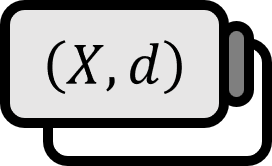Properties of Limits of Functions in Metric Spaces
Theorem 1
Let $(X,d)$ be a metric space, $E\subset X$ a subset, and $p$ an accumulation point of $E$. Suppose two complex-valued functions defined on $E$, $f:E\to \mathbb{C}$ and $g: E\to \mathbb{C}$, are given. Furthermore, assume that these two functions have the following limits at $p$.
$$ \begin{equation} \lim \limits_{x \to p}f(x)=A \quad \text{and} \quad \lim \limits_{x \to p}g(x)=B \tag{1} \label{thm1} \end{equation} $$
Then, the following holds.
(a) $\lim \limits_{x \to p}(f+g)(x)=A+B$
(b) $\lim \limits_{x \to p}(fg)(x)=AB$
(c) $\lim \limits_{x \to p}\left( \frac{f}{g} \right)(x) = \frac{A}{B},\ B\ne 0$
Proof
(a)
Let’s assume $X$, $Y$, $E$, and $f$, $p$ as described in the definition. Then, the following two propositions are equivalent.
$\lim \limits_{x\to p}f(x) = q$
For all sequences $\left\{ p_{n} \right\}$ of $E$ that are $p_{n}\ne p$ and $\lim \limits_{n\to\infty}p_{n}=p$,
$$ \lim \limits_{n\to\infty}f(p_{n})=q $$
By Lemma 1, showing (1a) is equivalent to showing that the sequence $\left\{ (f+g)(p_{n}) \right\}$ converges to $A+B$ for all sequences $\left\{ p_{n} \right\}$ converging to $p$. However, considering $\eqref{thm1}$, the sequences $\left\{ f(p_{n}) \right\}$ and $\left\{ g(p_{n}) \right\}$ converge to $A$ and $B$, respectively.
Let $\left\{ s_{n} \right\}$, $\left\{ t_{n} \right\}$ be sequences of real (or complex) numbers, and suppose $\lim \limits_{n\to\infty} s_{n}=s$, $\lim\limits_{n\to\infty}t_{n}=t$. Then, the following holds.
$\lim \limits_{n\to\infty}(s_{n}+t_{n})=s+t$
$\lim \limits_{n\to\infty} s_{n}t_{n}=st$
$\forall s_{n}\ne 0,s\ne0,\quad \lim \limits_{n\to\infty}\frac{1}{s_{n}}=\frac{1}{s}$
By the first property of Lemma 2, for all sequences $\left\{ p_{n} \right\}$ converging to $p$, the following holds.
$$ \lim \limits_{n\to\infty} (f(p_{n})+g(p_{n}))=A+B $$
■
(b) (c)
Similarly, each of the second and third properties of Lemma 2 holds.
■
Theorem 2
Similarly to Theorem 1, let’s assume $\mathbf{f}:E \to \mathbb{R}^{k}$, $\mathbf{g}:E\to \mathbb{R}^{k}$. And consider
$$ \lim \limits_{x \to p}\mathbf{f}(x)=\mathbf{A} \quad \text{and} \quad \lim \limits_{x \to p} \mathbf{g}(x)=\mathbf{B} $$
Then, the following holds.
$$ \lim \limits_{x \to p} (\mathbf{f}\cdot \mathbf{g})(x)=\mathbf{A}\cdot \mathbf{B} $$
Using the properties of sequences converging in the Euclidean space $\mathbb{R}^{k}$, the result follows immediately and does not require a separate proof.
